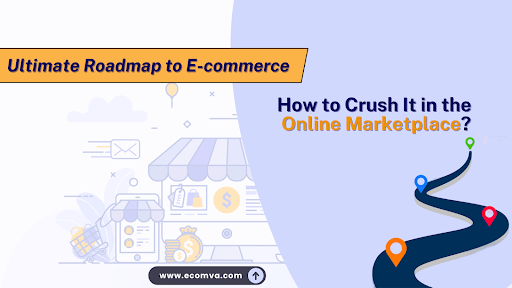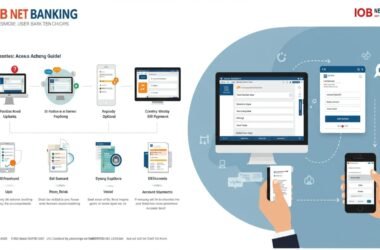Alright, let’s get real for a second. If you’ve ever dipped your toes into the world of E-commerce, you already know it’s no walk in the park. There’s no magic wand that turns your online store into a money-making machine overnight. But don’t panic! With the right strategy—and a solid roadmap—you’ll be cruising down the path to success like a pro.
So, grab a cup of coffee (or tea, no judgment here), and let’s break down exactly what you need to do to make your E-commerce business not just survive but thrive. Ready? Let’s go:
Why You Can’t Afford to Skip the E-commerce Roadmap?
Here’s the thing: without a plan, you’re driving blind. Sure, you can wing it, hoping that something works—but hope is not a great strategy. You would not build a house without having blueprints in hand, right? The same goes for your E-commerce business. An E-commerce roadmap gives you that step-by-step guide, laying out everything from how to build your brand to getting your first sale—and then your thousandth.
The U.S. E-commerce market alone is projected to hit $1.1 trillion by 2024. Yup, you read that right—trillion. Trust me, businesses that don’t have a plan in place are going to miss their cut of that pie. So, let’s talk about how you can snag your piece:
Step 1: Crafting Your E-commerce Strategy (AKA Your Business GPS)
Your E-commerce strategy is your guiding light. It’s what keeps you from veering off into shiny distractions that sound good but don’t really move the needle. Think of it as your business GPS—without it, you’ll end up lost in a maze of social media algorithms, product sourcing headaches, and endless marketing buzzwords.
Here is what you require to nail down first:
- Know Your Audience: This is non-negotiable. Who are you selling to? What do they need? Where do they hang out online? Get inside their heads. What makes them tick? What keeps them up at night?
- What Makes Your Product Stand Out?: Let’s be honest—there are a thousand other businesses selling what you’re selling (or close to it). So, what makes yours different? Whether it’s a unique product feature, killer customer service, or eco-friendly packaging, figure out your secret sauce.
- Sales Channels Matter: Selling on your own website is great, but you might be missing out if you’re not expanding to other platforms. Think Amazon, Etsy, eBay—or even direct selling on social media. Meet your customers where they are.
Here’s the twist: Your strategy isn’t set in stone. You need to be ready to tweak and adjust as you go. This is where most people fail—they think once they’ve got a plan, they’re set for life. Spoiler: you’re not.
Step 2: Running a Tight Ship with E-commerce Operations
Okay, now that you know where you’re headed, let’s talk about the behind-the-scenes stuff—the E-commerce operations. It’s not glamorous, but it’s the engine that keeps your business running. Trust me, without well-oiled operations, you’ll be drowning in orders, complaints, and returns before you know it.
Let’s break it down:
- Inventory Management: It can be called the lifeblood of your E-commerce business. You can’t sell what you don’t have. Keeping track of your inventory across multiple channels can get messy, fast. The solution? A centralized system. Tools like Shopify or WooCommerce are game-changers here.
- Order Fulfillment: Here’s where a lot of E-commerce businesses drop the ball. Customers today want their orders yesterday. If you’re not fast and efficient, they’ll bounce to a competitor who is. Think about how you can streamline this—whether through automation, third-party logistics, or even just tightening up your internal processes.
- Customer Support: Ever had a terrible customer service experience? Of course, you have. Also, you probably never went back to that particular company. Customer support is something where loyalty is lost or won. Whether it’s a live chat feature, a dedicated email team, or even an E-commerce virtual assistant, make sure your customers know you care.
Here’s where things get interesting: If you do operations right, your customers won’t even notice. It’ll be smooth sailing for them—and less stress for you. Win-win, right?
Step 3: Get Help Where You Can—E-commerce Virtual Assistants to the Rescue
You can’t do it all. The sooner you can accept that, the better results you can achieve. Running an E-commerce business can be compared to juggling flaming swords. You’ve got marketing, inventory, customer service, sales—all happening at once. But you do not require to do it alone.
This is where E-commerce virtual assistants come into play. These pros can take a ton of tasks off your plate—anything from order processing to customer inquiries and even managing your social media. Here’s the kicker: they’re often way more affordable than hiring full-time staff.
You get to focus on what you do best (like growing your business), and they handle the nitty-gritty. Think of it as outsourcing the chaos so you can keep your eye on the prize.
Step 4: Don’t Get Left Behind—Keep Up with E-commerce Trends
E-commerce is like fashion—it’s always changing. What’s hot today might be outdated tomorrow, and staying on top of E-commerce trends is the key to staying relevant. Don’t be that business stuck in 2015 wondering why your sales are tanking.
Let’s talk about some trends you can’t afford to ignore:
- Mobile Shopping: Seriously, mobile commerce is booming. By 2025, a whopping 72.9% of E-commerce sales are expected to come from mobile devices. If your site isn’t mobile-friendly, you’re leaving money on the table. Period.
- Personalization: Customers expect you to know them. Not in a creepy, stalker way—but in a way that shows you care about their preferences. Businesses that nail personalization see up to 15% more revenue. Offer personalized product recommendations, tailor your emails—go that extra mile.
- Sustainability: Consumers are paying attention to their impact on the environment, and they want to shop with businesses that do the same. Offering eco-friendly packaging or supporting sustainable practices? Your customers are going to love you for it.
Staying ahead of trends keeps you from becoming irrelevant. It’s that simple.
Step 5: E-commerce Best Practices—The Secret Sauce to Long-term Success
Alright, we’re in the home stretch now. You’ve got your strategy, you’re optimizing your operations, and you’re keeping an eye on trends. But how do you ensure your success isn’t just a flash in the pan? By sticking to E-commerce best practices that have been proven to stand the test of time.
Here’s what you need to lock down:
- SEO Optimization: If you’re not showing up in search engines, you’re invisible. Seriously. Take the time to optimize your product descriptions, blog content, and landing pages with keywords that matter. But don’t go overboard—Google’s too smart for that.
- User Experience (UX): People don’t have the patience for a clunky website. In case your website is confusing, slow, or not mobile-friendly, they are most likely to leave it. So, you should focus on keeping it clean, simple, and easy to navigate.
- Email Marketing: Email is not dead. In fact, it’s one of the most cost-effective ways to keep your customers coming back. Build relationships with personalized emails, exclusive offers, and helpful tips. It’s all about staying top of mind.
- Data Analytics: Numbers don’t lie. Dive into your analytics regularly—whether it’s tracking conversion rates, customer behaviors, or ad performance. The more you know, the better decisions you would be able to make.
Conclusion: Your Road to E-commerce Success Starts Now
And there you have it—your ultimate roadmap to E-commerce success. Is it going to be easy? Nope. But is it worth it? Absolutely. You’ve got the tools, the tips, and the strategy to make it happen. Now, it is up to you to take certain action.
Remember, every step you take on this journey is bringing you closer to your goals. There will be bumps, detours, and maybe even a few flat tires along the way. But with this roadmap in hand, you’re more than ready to handle whatever comes your way.
So, are you ready to take the wheel? Let’s go build something amazing.








